
Udea fulvalis is a species of moth of the family Crambidae. It was first described by Jacob Hübner in 1809.

Udea ferrugalis, the rusty dot pearl, is a moth of the family Crambidae. The species was first described by Jacob Hübner in 1796.

Udea lutealis is a species of moth of the family Crambidae described by Jacob Hübner in 1809.

Udea prunalis is a moth of the family Crambidae. It is found in Europe and China. The species was first described by Michael Denis and Ignaz Schiffermüller in 1775. In the Butterfly Conservation's Microlepidoptera Report 2011 this species was classified as common in the UK.

Monopis obviella is a species of tineoid moth. It belongs to the fungus moth family (Tineidae), and therein to the nominate subfamily Tineinae. It is the type species of Blabophanes, today treated as a junior synonym of the genus Monopis. M. crocicapitella was only separated from the present species in 1859, and is still frequently confused with it even by rather recent sources.

Udea is a genus of snout moths in the subfamily Spilomelinae of the family Crambidae. The genus was erected by Achille Guenée in 1845. The currently known 215 species are present on all continents except Antarctica. About 41 species are native to Hawaii.

Coranarta cordigera, the small dark yellow underwing, is a moth of the family Noctuidae. The species was first described by Carl Peter Thunberg in 1788. It can be found in parts of Europe, mainly in the north. In central and southern Europe it is only found in mountainous areas. In the Alps for instance, it is found up to elevations of 2,200 meters.
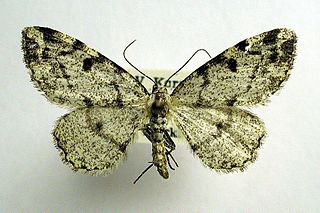
Alcis jubata, the dotted carpet, is a moth of the family Geometridae. The species was first described by Carl Peter Thunberg in 1788. It is found in central Europe, Scandinavia and northern Italy.
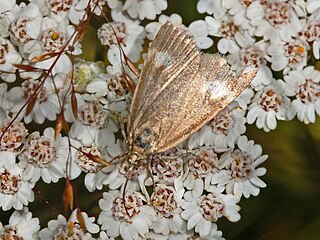
Udea alpinalis is a moth of the family Crambidae. The species was first described by Michael Denis and Ignaz Schiffermüller in 1775. It is an alpine species found in Europe.

Coleophora albella is a moth of the family Coleophoridae. It is found in most of Europe.
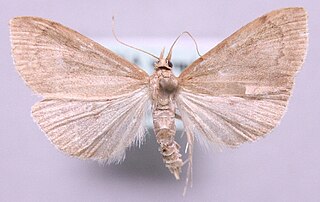
Udea accolalis is a species of moth in the family Crambidae described by Philipp Christoph Zeller in 1867. It is found in France, Switzerland, Italy, Austria, the Czech Republic, Slovakia, Hungary, Poland, Romania, Ukraine, Belarus, the Baltic region, Finland, Sweden and Russia.
Udea costalis is a species of moth in the family Crambidae described by Eduard Friedrich Eversmann in 1852. It is found in Spain, France, Poland, Lithuania, Latvia, Russia, Kyrgyzstan and China.
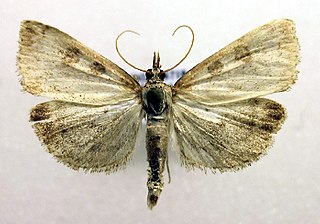
Udea elutalis is a species of moth in the family Crambidae. The species was first described by Michael Denis and Ignaz Schiffermüller in 1775. It is found in Spain, France, Germany, Switzerland, Austria, Italy, Slovakia, the Czech Republic, Poland, Romania, Estonia, Finland, Russia and Kazakhstan. It is also found in China.
Udea inquinatalis is a species of moth in the family Crambidae. The species was first described by Friederike Lienig and Philipp Christoph Zeller in 1846. It is found in most of Europe and North America.
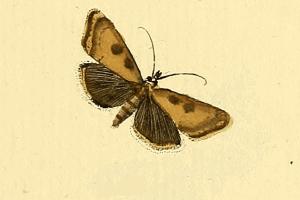
Udea nebulalis is a species of moth in the family Crambidae. It is found in France, Switzerland, Austria, Italy, Germany, Poland, the Czech Republic, Slovakia, Slovenia, Croatia, Bosnia and Herzegovina, Serbia and Montenegro, Bulgaria, Romania, Estonia and Fennoscandia.

Udea numeralis is a species of moth in the family Crambidae described by Jacob Hübner in 1796. It is found in Southern Europe and North Africa.
Udea exigualis is a moth in the family Crambidae. It was described by Alfred Ernest Wileman in 1911. It is found in Japan, China and Pakistan.
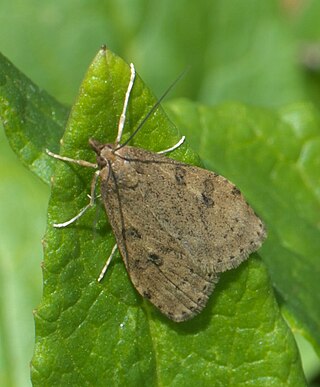
Udea turmalis is a moth in the family Crambidae. It was described by Augustus Radcliffe Grote in 1881. It is found in North America, where it has been recorded from Alberta, Arizona, British Columbia, California, Colorado, Idaho, Manitoba, Montana, Nevada, New Mexico, Utah and Washington.
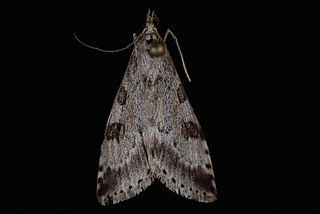
Udea washingtonalis, the Washington udea moth, is a moth in the family Crambidae. It was described by Augustus Radcliffe Grote in 1882. It is found in North America, where it has been recorded from Alaska, British Columbia, California, Montana and Washington.














